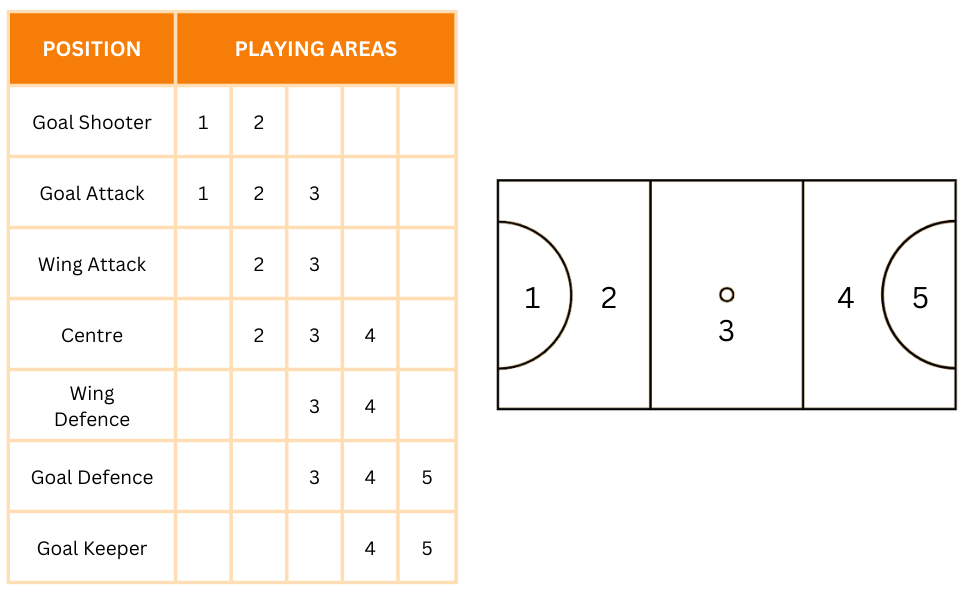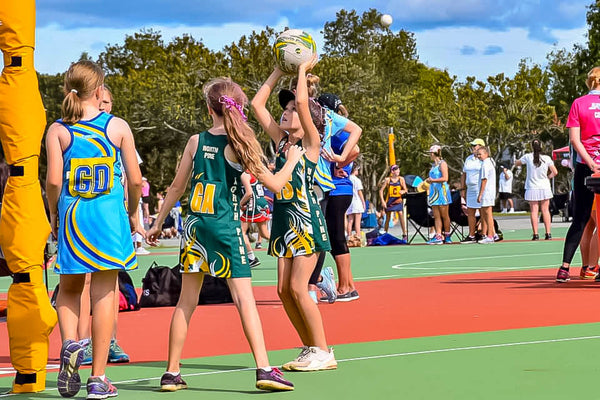How to Play Netball | Learn everything about the Game of Netball
Posted by RICHARD TINKER
Netball Guide: Everything you need to know about How to Play Netball
We’ve broken the game down to give you a basic guide to the great game of netball. A quick read on all the key points you need to know when learning about Netball, the rules of the game and how to get playing.
In this article about Netball, you will find:
- Netball Positions, their name, place and what to do for each position
- The Netball Court: Playing Areas, what it looks like
- The Rules of Netball: A simple guide to netball
- Netball Ball: Ball Size guide for each age
- Netball and how to get involved
Netball Positions and Roles of each Netball Player
There are seven playing positions in a netball team. Each has an important role to play. Below is a table with each Netball Position, what they do and where they are allowed to be on the Netball Court:
Goal Shooter (GS) |
Score goals and work in and around the circle with the Goal Attack. Must stay in attacking third. |
Goal Attack (GA) |
Work with the Goal Shooter and score goals. Allowed in the Centre third and attacking third including the goal circle. |
Wing Attack (WA) |
Feed the circle players giving them shooting opportunities. Can go in the Centre third and attacking third excluding goal circle. |
Centre (C) |
Takes the centre pass and links the defence and the attack. Can go anywhere except the goal circles. |
Wing Defence (WD) |
Make interceptions and prevent the Wing Attack from feeding the ball into the circle. Is allowed in the Centre Third and Defensive third excluding the goal circle. |
Goal Defence (GD) |
Try to win the ball and reduce the effectiveness of the Goal Attack. Centre and defensive third excluding goal circle. |
Goal Keeper (GK) |
To work with the GD and to prevent the GA/GS from scoring goals. Only allowed in their defensive goal third. |

The Rules of Netball Matches:
Games run for 60 minutes with 4 x 15 minute quarters and a break a half time. A coin toss determines who starts with the ball. The center pass then alternates throughout the game regardless of which team has scored.
There must be at least 5 players to start the game, one of which needs to play Centre. If more players arrive, they can only join at the next center pass/after the next goal is scored.
All players must start in the goal thirds except for the two Centres. The Centre with the ball starts in the Centre Circle with at least one foot. The opposing Centre can be anywhere within the Centre Third.
Players must move quickly after the whistle is blown and get into a position to receive the ball in the Centre third (for players allowed to be in centre third).
You cannot run with the ball. Once you have caught the ball, your landing foot - the foot you placed down first, cannot be moved, the other foot can be used to pivot.

You can only take 1.5 steps while holding the ball and you can only hold the ball for up to 3 seconds.
Players can only move in their designated areas otherwise a free pass will be awarded to the other team.
Only the Goal Shooter and Goal Attack can score goals for their team.
When restarting, the Centre must not delay getting to the centre circle to start otherwise a penalty will be given.
Players must be at least 3 feet away from a player with the ball while defending. If you’re too close then the player with the ball will be awarded a penalty. You then must step aside and let the player take the penalty. You can’t interfere until the player has passed the ball.
The rules may seem confusing at first but once you get started you’ll soon get the hang of it and enjoy working as a team to get the netball in the net.
What size Netball Ball do I need?
- Juniors under 10 play with a size 4 netball SEE BALLS HERE
- Players 10 and over play with a size 5 netball SEE BALLS HERE
How do you get involved in Netball?
For young kids, try NetSetGo which is Australia's official starter program for girls and boys aged 5-10. It's a great program to learn the netball basics, in a fun environment.
If you have school-aged kids, often netball is included in the physical education program where your child can get a feel of the sport and understand how it is played. From there, find a local club and join up. There are always clubs looking to welcome new players.

Looking for something a bit more casual? Check your state netball association for social programs.
Ever heard of walking netball? Walking Netball is a slower version of the game; it is netball, but at a walking pace. The game is designed so anyone can play, regardless of age, ability or fitness level. It's a great way to stay active with minimal risk of injury.
Whether you choose to compete competitively or socially, netball always provides opportunity to gain new experiences and friends.
Netball is a great game to get involved in as it helps to create skills in teamwork, leadership, agility, coordination and is of course fantastic exercise. There’s not much equipment you need to get started, you just need access to a netball court, netball, netball shoes or runners and a water bottle. For club games you’ll also need a uniform.
Netball is technically a non-contact sport however it is a fast paced game where you’re in close proximity to others so some contact does happen. It’s important to cut fingernails low and remove jewelry before playing, it’s also a good idea to tie hair back.
We hope you now have a better understanding of the game of netball. Check out the gear you need to get playing here. We have a fantastic range of netballs from Aussie netball legends Maddy Turner and Liz Ellis as well as training equipment, apparel and accessories.


